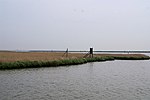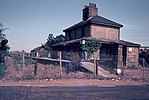Berney Arms
Pubs in NorfolkVillages in Norfolk

Berney Arms is a settlement on the north bank of the River Yare, close to Breydon Water in the English county of Norfolk. It is part of the civil parish of Reedham, in the district of Broadland, and lies within The Broads. It comprises a railway station, a windmill, a farmhouse and a pub which closed in late 2015 (though permission for conversion to a dwelling was refused, and campaigners are seeking to reopen it as a pub). In 2020, an adjacent property opened as a bistro. The area is not accessible by public road.
Excerpt from the Wikipedia article Berney Arms (License: CC BY-SA 3.0, Authors, Images).Berney Arms
Beccles Road,
Geographical coordinates (GPS) Address Nearby Places Show on map
Geographical coordinates (GPS)
| Latitude | Longitude |
|---|---|
| N 52.588535 ° | E 1.641424 ° |
Address
Berney Arms Windmill
Beccles Road
NR31 9FQ
England, United Kingdom
Open on Google Maps










